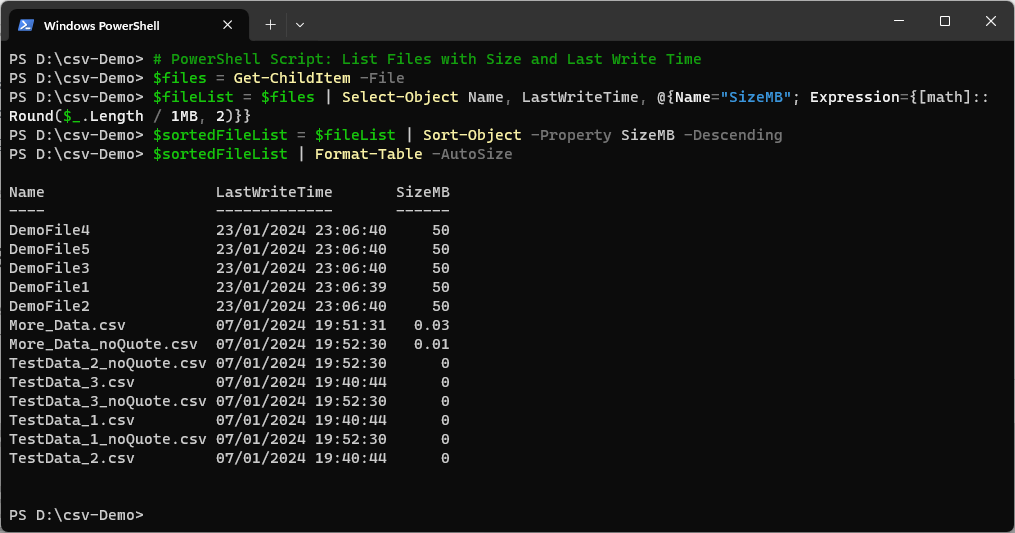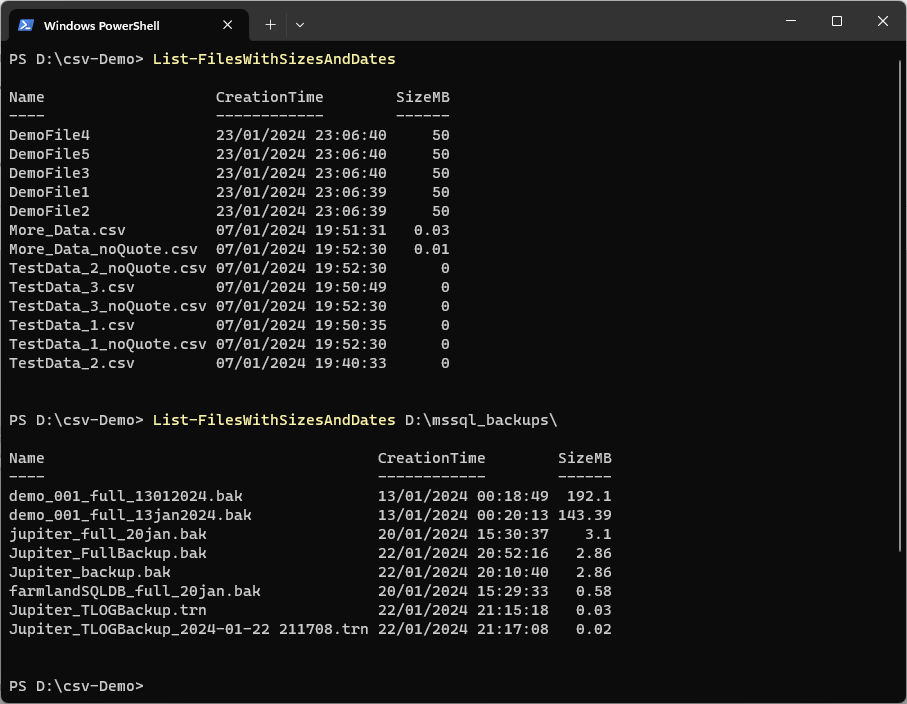-

PowerShell Script: List Files with Sizes and Dates
In this blog post, we’ll go through the steps for using a PowerShell script that lists files in a directory along with their sizes and creation dates. This script is useful for disk space and for checking old files in a folder.
List Files with Size and Last Write Time
The following PowerShell script provides admins a quick overview of the files in the current directory, ordered by file size (MB) from highest to lowest.
PowerShell Script:
# PowerShell Script: List Files with Size and Last Write Time $files = Get-ChildItem -File $fileList = $files | Select-Object Name, LastWriteTime, @{Name="SizeMB"; Expression={[math]::Round($_.Length / 1MB, 2)}} $sortedFileList = $fileList | Sort-Object -Property SizeMB -Descending $sortedFileList | Format-Table -AutoSize
How It Works
> Get-ChildItem: Retrieves all files in the current directory using the-Fileparameter.
> Select-Object: Creates a custom object for each file with its name, last write time, and size in megabytes.
> Sort-Object: Orders the files by size in descending order.
> Format-Table: Displays the sorted file list in a table format.Making It a Function
For better reusability, we can turn the script into a function:
# PowerShell Function: List-FilesWithSizesAndDates Function List-FilesWithSizesAndDates { param( [string]$directoryPath = (Get-Location) ) $files = Get-ChildItem -Path $directoryPath -File $fileList = $files | Select-Object Name, CreationTime, @{Name="SizeMB"; Expression={[math]::Round($_.Length / 1MB, 2)}} $sortedFileList = $fileList | Sort-Object -Property SizeMB -Descending $sortedFileList | Format-Table -AutoSize }Example usage:
# List files in the current directory List-FilesWithSizesAndDates # List files in a specific directory List-FilesWithSizesAndDates -directoryPath "d:\mssql_backups"

This function makes it easy to organize files by size and date, helping you quickly find large or old files that might need archiving or deletion. It’s also great for auditing, letting you track file creation dates for better record-keeping. Plus, you can name the function whatever you like, customizing it to fit your workflow and making your terminal experience even smoother.
-
Why Is the Database in “In Recovery” Mode?
In this post I’m hoping to help you resolve issues if your SQL Server Database is stuck “in Recovery” Mode.
SQL Server enters recovery mode to ensure data integrity by:
> Analyzing Transactions: Identifies changes since the last checkpoint.
> Redoing Transactions: Reapplies committed changes not yet written to the database files.
> Undoing Transactions: Rolls back uncommitted transactions.This process is automatic but can take time, especially with large databases or extensive transaction logs. However, sometimes we need to run some commands to help things along and recovery your db.
How to Resolve Database in Recovery Mode
1. Wait for Recovery to Complete
Recovery is often just a matter of time and waiting it out. Check the SQL Server Error Log for progress updates, such as:Recovery of database 'DatabaseName' is 50% complete. Phase 2 of 3.If recovery progress is visible, try avoid interrupting the process. You could try monitor recovery progress by checking currently running processes on the database.
2. Restore the Database
If recovery seems stuck or incomplete, manually restore the database using the following command:-- recovery from database in recovery RESTORE DATABASE [YourDatabaseName] WITH RECOVERY;
This command finalizes a recovery process. If you encounter issues, ensure no active connections are blocking the restore.
3. Set the Database Offline and Online
If recovery fails, try resetting the database state:
-- Set database offline ALTER DATABASE [YourDatabaseName] SET OFFLINE WITH ROLLBACK IMMEDIATE; -- Set database online ALTER DATABASE [YourDatabaseName] SET ONLINE;
Additional Resources
By following these steps, you should be able to resolve most issues with databases stuck in “In Recovery” mode (I hope). If the problem persists, consider checking for underlying causes, such as large transaction logs or excessive virtual log files (VLFs). You could also add a comment below and I’ll try assist!
Hope this was useful. For more details, check out the Microsoft Documentation: Restore and Recovery Overview (SQL Server)
-
How to View the Definition of a Stored Procedure
In this post, I’m sharing some SQL Scripts that will help you view the definition text of Stored Procedures and other objects in SQL Server.
Ways to Query Stored Procedure Text
Like a lot of tasks in MSSQL, there’s various ways we can get this information, including:
>sys.sql_modules: A catalog view that stores SQL language-defined module definitions, including Stored Procedures, Views, Functions, and Triggers.
>OBJECT_DEFINITION: A system function that retrieves the definition of a specified object.
>sp_helptext: A system procedure for listing the text of objects (not supported in Azure Synapse Analytics).For this demo, we’ll focus on
sys.sql_modulesandOBJECT_DEFINITION, as both are supported in Azure and provide reliable results.Additionally, you could achieve similar results using PowerShell scripts, but I’ll keep examples purely SQL-based.
Searching for Stored Procedure Text
The
sys.sql_modulescatalog view contains a row for each object that has a SQL language-defined module. This includes:
– Stored Procedures (P)
– Replication Filters (RF)
– Views (V)
– Triggers (TR)
– Scalar User-Defined Functions (FN)
– Inline Table-Valued Functions (IF)
– Table-Valued Functions (TF)
– Rules (R)Even stand-alone default objects (
D) have their definitions stored here. For a complete list of object types, refer to thetypecolumn in thesys.objectscatalog view.Example 1: Searching with
sys.sql_modulesYou can search for specific text within stored procedure definitions using this query:
-- Search for text within stored procedure definitions using sys.sql_modules SELECT o.name FROM sys.sql_modules m INNER JOIN sys.objects o ON m.object_id = o.object_id WHERE m.[definition] LIKE '%ErrorHandler%' AND o.type = 'P';This query returns the names of all stored procedures that contain the string
ErrorHandlerin their definitions.📌 Real-Life Scenario: Imagine you’re migrating a database, and you want to identify all procedures referencing a legacy feature like a deprecated table or column. Searching with
OBJECT_DEFINITIONis a quick way to locate those references.Example 2: Using
OBJECT_DEFINITIONAlternatively, you can use the
OBJECT_DEFINITIONfunction directly to retrieve an object’s definition. For example:-- get an objects definition USE AdventureWorks2022; GO SELECT OBJECT_DEFINITION(OBJECT_ID(N'dbo.uspLogError'));
Or, when combined with
sys.sql_modules:-- get definition of object USE AdventureWorks2022; GO SELECT [definition] FROM sys.sql_modules WHERE object_id = OBJECT_ID(N'dbo.uspLogError');
📌 Tip: Use
OBJECT_DEFINITIONfor quick lookups andsys.sql_moduleswhen you need to integrate with other metadata from the catalog view, such asmodify_dateoris_schema_bound.That’s It!
That’s it for this quick post. For more information, check out the Microsoft documentation on querying stored procedure definitions, which includes T-SQL examples for the other two ways to get object definitions.
-
SQL Script to Show Exclusive Locks on Tables
In this post I’m sharing a SQL script that will show exclusive locks for all tables in a database, with added info to help you understand what we’re looking at.
Exclusive locks are a natural thing in SQL Server which ensures data integrity during updates or deletions by preventing other transactions from accessing the locked resource. However, prolonged exclusive locks can cause performance issues, especially when planning maintenance tasks or deploying schema changes.
Script to Show Exclusive Locks
The script below identifies and displays details about exclusive locks (and other lock types) on tables within a passed SQL Server database. This helps DBA’s locate and troubleshoot potential blocking or performance issues caused by locked resources.
Output:
UserName:The login name of the user holding the lock.SessionID:The unique session ID for the locking session.HostName:The machine where the session originated.ObjectName:The name of the locked object, usually a table.ObjectType:The type of the object (e.g., USER_TABLE, SYSTEM_TABLE).ResourceType:The resource type being locked (e.g., OBJECT, PAGE, KEY).LockStatus:The status of the lock (e.g., GRANTED or WAIT).LockType:A descriptive name for the lock mode (e.g., Exclusive, Shared).ProgramName:The application responsible for the session (e.g., SSMS, SQLAgent).ClientInterface:The interface used to connect (e.g., ODBC Driver, ADO.NET).This is a custom script I’ve made while writing this post. I’ll update if I find any faults or useful updates. The
sys.dm_tran_locksMS Docs page is particularly useful for further information on understanding each columns meaning.Operations Blocked and Allowed with Exclusive Locks
When a table has an exclusive lock, certain operations are blocked, while others may still be possible depending on the type and level of the lock applied.
SQL Server uses different lock types, like exclusive (X), shared (S), and intent (I), and lock levels (row, page, or table) to manage concurrency and ensure data integrity. For example, an exclusive lock (X) prevents other transactions from accessing or modifying the locked resource, but the lock’s granularity (row, page, or table) determines if other parts of the table can still be used.
What Can’t Be Done
Reading or Writing Data:
Other transactions cannot modify or acquire shared locks to read the locked data. Using theNOLOCKtable hint allows reading data, but this can result in dirty reads (uncommitted data) or inconsistent results.
Schema Changes:
ALTER, DROP, or adding the table to replication is blocked due to schema-related locks.
Truncating the Table:
TRUNCATE is restricted due to conflicts with schema-level locks that prevent structural changes during a lock.What Can Be Done
Identify Blocking Transactions:
Use system views likesys.dm_tran_locksorsp_who2to locate the cause of the block.
Access Unlocked Parts:
If the lock is row- or page-specific, other parts of the table may still be accessible for reading or writing.Managing Exclusive Locks During Changes
To minimize the impact of exclusive locks, it’s important to plan changes during off-peak hours and schedule maintenance windows when database activity is low. If you’re struggling to perform a DDL change on a table, consider arranging application downtime to allow the operation to complete without interference. For tasks like adding a table to replication, you can populate the subscriber first and then use the replication support-only option to avoid conflicts, ensuring smoother changes with minimal disruption.
These strategies should help you maintain performance and reduce the risk of lock contention during critical operations. As a follow-up, you could also be checking the currently running SPIDs on your SQL Server for more information on busy periods.
